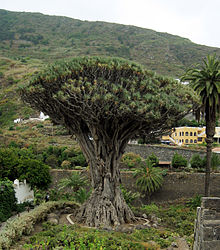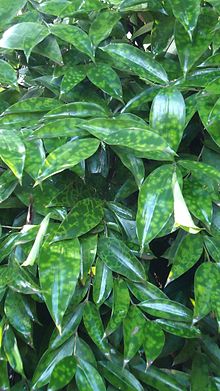- Dracaena (plant)
-
Dracaena 
Dracaena draco Scientific classification 
Kingdom: Plantae clade: Angiosperms clade: Monocots Order: Asparagales Family: Asparagaceae Subfamily: Nolinoideae Genus: Dracaena
Vand. ex L.[1]Species See text
Synonyms  "Lucky Bamboo", Dracaena sanderiana
"Lucky Bamboo", Dracaena sanderiana
Dracaena (
 /drəˈsiːnə/,[2] derived from the romanized form of the Ancient Greek δράκαινα - drakaina, "female dragon") is a genus of about 40 species of trees and succulent shrubs. In the APG III classification system, it is placed in the family Asparagaceae, subfamily Nolinoideae (formerly the family Ruscaceae).[3] It has also formerly been separated (sometimes with Cordyline) into the family Dracaenaceae or placed in the Agavaceae (now Agavoideae). The majority of the species are native in Africa, with a few in southern Asia and one in tropical Central America. The segregate genus Pleomele is now generally included in Dracaena. The genus Sanseviera is closely related, and has recently been synonymized under Dracaena in the Kubitzki system.
/drəˈsiːnə/,[2] derived from the romanized form of the Ancient Greek δράκαινα - drakaina, "female dragon") is a genus of about 40 species of trees and succulent shrubs. In the APG III classification system, it is placed in the family Asparagaceae, subfamily Nolinoideae (formerly the family Ruscaceae).[3] It has also formerly been separated (sometimes with Cordyline) into the family Dracaenaceae or placed in the Agavaceae (now Agavoideae). The majority of the species are native in Africa, with a few in southern Asia and one in tropical Central America. The segregate genus Pleomele is now generally included in Dracaena. The genus Sanseviera is closely related, and has recently been synonymized under Dracaena in the Kubitzki system.Contents
Description
Species of Dracaena have a secondary thickening meristem in their trunk. This monocotyledonous secondary thickening meristem is quite different from the thickening meristem found in dicotyledonous plants and is termed dracaenoid thickening by some authors. This character is shared with members of the Agavoideae and Xanthorrhoeoideae among other members of the Asparagales.
D. americana, D. arborea, D. cinnabari, D. draco, D. ombet, and D. tamaranae are commonly known as dragon trees and grow in arid semi-desert areas. They are tree-sized with stout trunks and stiff, broad-based leaves. The remaining species are known collectively as shrubby dracaenas. They are smaller and shrub-like, with slender stems and flexible strap-shaped leaves, and grow as understorey plants in rainforests.
Species
- Dracaena americana – Central America Dragon Tree
- Dracaena aletriformis (Haw.) Bos)
- Dracaena arborea – Tree Dracaena
- Dracaena aubryana Brongn. ex E.Morren (=D. thalioides)
- Dracaena bicolor Hook.
- Dracaena cincta
- Dracaena cinnabari Balf.f. – Socotra Dragon Tree
- Dracaena concinna Kunth
- Dracaena draco (L.) L. – Canary Islands Dragon Tree
- Dracaena elliptica
- Dracaena fragrans (L.) Ker Gawl. (=D. deremensis) – Striped Dracaena, Compact Dracaena, corn plant, Cornstalk Dracaena
- Dracaena goldieana W.Bull
- Dracaena hookeriana
- Dracaena mannii
- Dracaena marginata Lam. – Red-edged Dracaena or Madagascar Dragon Tree: see Dracaena reflexa var. angustifolia
- Dracaena marmorata
- Dracaena ombet – Gabal Elba Dragon Tree
- Dracaena phrynioides
- Dracaena reflexa Lam. – Pleomele Dracaena or "Song of India"
- Dracaena sanderiana Sander ex Mast. – Ribbon Dracaena, marketed as "Lucky Bamboo"
- Dracaena serrulata Yemen Dragon Tree
- Dracaena surculosa Lindl. – Spotted Dracaena or Gold Dust Dracaena
- Dracaena tamaranae – Gran Canaria Dragon Tree
- Dracaena umbraculifera Jacq.[4]
Formerly placed here
- Asparagus asparagoides (L.) Druce (as D. medeoloides L.f.)
- Cordyline australis (G.Forst.) Endl. (as D. australis G.Forst.)
- Cordyline fruticosa (L.) A.Chev. (as D. terminalis Lam.)
- Cordyline indivisa (G.Forst.) Steud. (as D. indivisa G.Forst.)
- Cordyline obtecta (Graham) Baker (as D. obtecta Graham)
- Cordyline stricta (Sims) Endl. (as D. stricta Sims)
- Dianella ensifolia (L.) DC. (as D. ensifolia L.)
- Liriope graminifolia (L.) Baker (as D. graminifolia L.)
- Lomandra filiformis (Thunb.) Britten (as D. filiformis Thunb.)[4][5]
Uses
Ornamental
Some shrubby species, such as D. deremensis, D. fragrans, D. godseffiana, D. marginata, and D. sanderiana, are popular as houseplants. Many of these are toxic to pets, though not humans, according to the ASPCA among others. Rooted stem cuttings of D. sanderiana are widely marketed in the U.S.A. as "Lucky Bamboo", although only superficially resembling true bamboos.
Other uses
A bright red resin, dragon's blood, is produced from D. draco and, in ancient times, from D. cinnabari. Modern dragon's blood is however more likely to be from the unrelated Daemonorops rattan palms.
References
Notes
- ^ a b "Genus: Dracaena Vand. ex L.". Germplasm Resources Information Network. United States Department of Agriculture. 2010-01-19. http://www.ars-grin.gov/cgi-bin/npgs/html/genus.pl?3962. Retrieved 2011-02-07.
- ^ Sunset Western Garden Book. 1995. pp. 606–607. ISBN 0376038519.
- ^ Chase, M.W.; Reveal, J.L. & Fay, M.F. (2009). "A subfamilial classification for the expanded asparagalean families Amaryllidaceae, Asparagaceae and Xanthorrhoeaceae". Botanical Journal of the Linnean Society 161 (2): 132–136. doi:10.1111/j.1095-8339.2009.00999.x
- ^ a b "GRIN Species Records of Dracaena". Germplasm Resources Information Network. United States Department of Agriculture. http://www.ars-grin.gov/cgi-bin/npgs/html/splist.pl?3962. Retrieved 2011-02-07.
- ^ Dracaena names. Multilingual Multiscript Plant Name Database.
General references
- Waterhouse, J. T. (1987). "The Phylogenetic Significance of Dracaena-type growth". Proc. Linn. Soc. N.S.W. 109: 129–128.
External links
 Media related to Dracaena at Wikimedia Commons
Media related to Dracaena at Wikimedia Commons  Data related to Dracaena at Wikispecies
Data related to Dracaena at Wikispecies- Socotra botany. Royal Botanic Garden, Edinburgh.
Categories:- Dracaena
- Asparagaceae genera
- Medicinal plants
- Plants used in Traditional Chinese medicine
Wikimedia Foundation. 2010.



